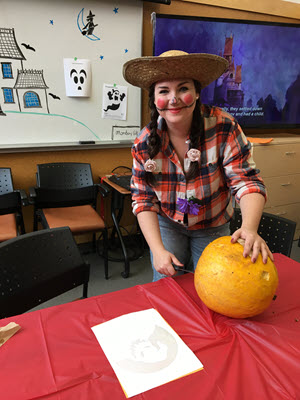by Kristen Matwychuk, PHEc
Whether you’re carving your pumpkin with a face that’s scary, sweet, or silly, there’s something incredibly satisfying about seeing your creation come to life.

But how can you ensure that your Jack-o’-lantern stays looking its best for as long as possible? Here are some tricks to ensure your pumpkin outlasts the ghouls and goblins on Halloween night:
- Look for pumpkins that are ripe, have a uniform orange color, and are free from cuts or bruises. A ripe pumpkin will have a hard shell that doesn’t dent easily when pressed, and its stem should be strong and firmly attached. Additionally, it’s best to purchase pumpkins stored inside stores to avoid a mushy gourd caused by the freeze-thaw cycle due to low outdoor temperatures.
- Carve your pumpkin as close to Halloween night as possible, aiming for only a day or two in advance.
- Instead of cutting a lid in the top of your pumpkin, cut a hole in the bottom. This will not only help to preserve the moisture inside the pumpkin, and prevent the top or sides from caving in, but also makes it easier to place over a light source to illuminate your design.
- Prevent mold growth and moisture loss by treating your pumpkin after carving, using either the bleach or Vaseline methods:
- Bleach method: Bleach will help to kill off any bacteria and slow down the decay process. Mix 1/4 cup of bleach with one gallon of water and use this to thoroughly rinse the inside of your pumpkin. If you plan to keep your pumpkin longer than a couple of days, submerge your pumpkin in the solution and soak for one to six hours.
- Vaseline method: After your pumpkin is carved and cleaned, apply a thin layer of petroleum jelly to all the cut surfaces. This will help to lock in the moisture and prevent your pumpkin from drying out.
One last tip for you, don’t sweat the small mistakes you might make while carving, as long as you’re safe and having fun, the rest is gravy. Happy carving!
Kristen is a Professional Home Economist with a degree in Food Sciences from the University of Manitoba’s Faculty of Agricultural and Food Sciences. She’s passionate about building agriculture and food literacy in Manitoba’s agri-food sector. Professionally, Kristen has built literacy through the development of educational resources and activities for school age kids, testing and promoting recipes, guiding farm tours, and teaching food handler’s certificate courses.






